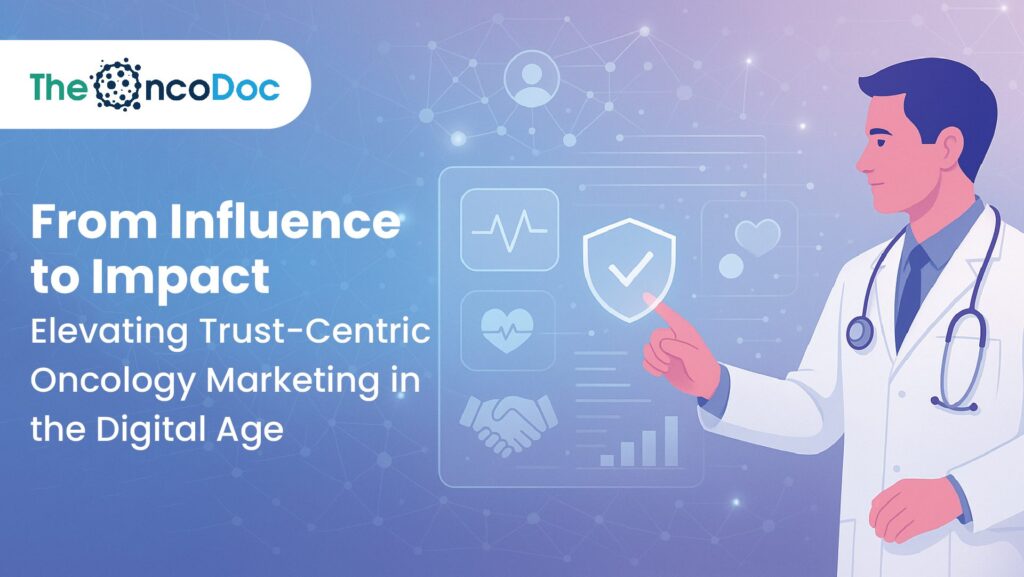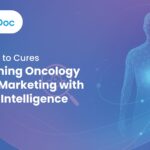Introduction: Repositioning Pharma from Promoter to Partner
In the oncology landscape, trust is more than a desirable trait; it is a strategic imperative. As scientific discoveries accelerate and treatment pathways become more nuanced, the way pharmaceutical companies communicate with healthcare professionals (HCPs) must evolve. Gone are the days of transactional sales interactions. Today’s oncologists seek meaningful, data-rich engagement that supports, not interrupts, their decision-making.
This article explores the next chapter of oncology marketing: how pharma brands can leverage digital technologies, data science, and clinician empathy to establish themselves as credible allies in the delivery of patient-centered care.
1. Redefining Digital Value: From Clicks to Clinical Credibility
Many marketers continue to focus on performance metrics like open rates, impressions, and ad reach. But oncology HCPs evaluate value differently;they care about whether the content improves their clinical confidence or adds real-world context.
Shifting Toward Value-Based Engagement:
- Highlight evidence, not emotion
- Prioritize clinical relevance over branding
- Offer content that fits into physicians’ existing workflows
Figure 1: Clinical relevance and peer-authored evidence continue to lead in HCP content demand.
While digital channels expand reach, they must not dilute empathy. Oncology HCPs are under immense cognitive and emotional burden. Effective marketing, therefore, should not just inform it must also respect their context. Content needs to be brief, emotionally sophisticated, and structured to acknowledge the tough choices oncologists have to make every day.
Strategies such as narrative medicine techniques in content (e.g., physician reflection stories or patient-journey visualizations) can deepen emotional resonance. Even microcopy subject lines, CTA buttons, and video descriptions can signal empathy and respect for the oncologist’s time.
Additionally, UX design should prioritize low-friction interactions: fewer clicks, mobile optimization, dark-mode support, and minimal login barriers. Trust is not only what we say it’s how easily and respectfully we say it.
2. Personalization Powered by AI: Precision Messaging, Not Mass Outreach
The advent of AI-driven customer relationship management allows brand teams to tailor outreach with surgical accuracy. These days, oncology professionals can be divided into groups based on more than just their specialty:
• Trial participation history
• Preferred channels and content formats
• Patterns of adherence to guidelines
• Peer network
AI Personalization Use Cases:
- Auto-tagging HCP behavior on portals to trigger Next Best Action (NBA) content
- Segmenting DOL webinars by tumor type relevance
- Delivering micro-content via WhatsApp or SMS based on engagement heatmaps
The top AI deployment areas in pharma-led oncology HCP engagement.
While much focus is placed on oncologists, trust-building must extend to the broader oncology care team especially nurses, pharmacists, and advanced practice providers. These professionals often spend more time with patients and are critical influencers of treatment adherence and care coordination.
Pharma companies can strengthen their brand equity by supporting educational needs specific to this audience. This includes on-demand peer-led films that correspond with actual clinical queries, quick-reference dosing guidelines, and microlearning courses on managing side effects.
Additionally, AI-powered personalization should identify and support these roles through differentiated outreach targeting nurse navigators with survivorship content or providing oncology pharmacists with drug-interaction calculators. By viewing the extended care team as strategic partners, not peripheral players, brands can embed themselves more holistically within the oncology decision-making ecosystem.
3. Building Trust through Peer-Generated Content Ecosystems
Peer-to-peer influence remains a dominant force in oncology. Pharma can support clinician-authored education rather than provide it.
Content Co-Creation Models:
- CME-accredited DOL sessions hosted on brand-neutral platforms
- Peer-moderated panels discussing real-world treatment dilemmas
- Guest-authored newsletters from regional oncologists
These interactions feel less intrusive and more authentic, significantly improving message uptake.
Example: A regional MSL-led tumor board recap newsletter (non-promotional) achieved 3x higher click-through rate than product-centric mailers.
Cross-Functional Collaboration: Aligning Brand, Medical, and Tech Teams
The promise of trust-centric marketing can only be realized if internal pharma teams break traditional silos. Alignment between medical affairs, marketing, legal/compliance, and data teams is now crucial.
For instance, while the brand team may seek quick engagement wins, the medical team can offer deeper insights into unmet clinical needs. Tech partners, meanwhile, can translate these insights into personalized content delivery systems.
Best-in-class oncology brands now adopt cross-functional “content steering committees” where medical and marketing co-review planned campaigns for clinical accuracy and empathy. AI tools further enhance this by flagging potential compliance or tone inconsistencies pre-launch.
4. From Omnichannel to Omnipurpose: Creating a Unified Content Journey
Rather than overloading oncologists across every channel, modern digital strategies must prioritize consistency of purpose over presence.
Smart Channel Sequencing:
- Deliver bite-sized insights via social (e.g., DOL clip on ASCO highlights)
- Follow-up with gated access to a full discussion (e.g., a CME webinar)
- Enable CRM-triggered content based on interaction depth (e.g., auto-email with case study link post-CME attendance)
Disparity between trust and frequency highlights the need for better channel calibration.
Trust is not just built by saying the right thing; it is preserved by knowing when not to speak. In the digital oncology ecosystem, oversaturation is a real threat. Constant alerts, uncoordinated touchpoints, or irrelevant reminders risk turning interest into irritation.
Smart pharma marketers now incorporate “digital silence windows,” periods of intentional disengagement based on engagement fatigue signals. AI systems can detect when HCPs stop clicking or quickly bounce from content, indicating oversupply or relevance drift.
Moreover, oncology calendars should be respected. During major conferences (ASCO, ESMO), brands should reduce outbound marketing unless directly aligned. Similarly, heavy clinical trial recruitment pushes should not overlap with peak clinical load periods.
Trust flourishes in thoughtful cadence. By practicing restraint, pharma demonstrates respect ultimately proving that presence isn’t power, but precision is.
Voice of the Oncologist: Feedback Loops and Co-Design
To create marketing that resonates, pharma must not just analyze HCP behaviors but invite their voices into content development. Closed-loop feedback systems allow for agile content optimization and strengthen trust.
Innovative brands now deploy periodic digital pulse surveys post-interaction (e.g., after a webinar or newsletter). These may include NPS-style questions (“How clinically valuable was this?”) or open-ended prompts. More advanced strategies involve real-time in-content feedback (like emoji sliders or 2-click sentiment scoring).
Going further, co-design panels where oncologists review and help shape content prototypes can elevate both quality and authenticity. These panels work best when diverse (urban vs. rural, academic vs. private practice) and compensated transparently.
This transformation turns the oncologist from passive recipient to co-architect of the message.
5. Making Ethics Actionable: Compliance as a Competitive Advantage
With increased scrutiny around digital promotions, transparent communication is not just required; it can differentiate brands. Ethical marketing is now a signal of long-term reliability.
Key Practices:
- All content approved through MLR teams, especially when AI-curated
- Transparent labeling of sponsored vs. peer-generated materials
- GDPR and local regulatory compliance for all HCP data collection

Trust in pharma content stems from clarity, objectivity, and compliance alignment.
As ESG (environmental, social, and governance) considerations gain traction in healthcare, oncology HCPs are increasingly scrutinizing not just the content of pharma’s message but the character of its messenger. Integrating sustainability and social justice themes into digital engagement can meaningfully enhance trust.
Environmentally, pharma marketers can reduce their carbon footprint by optimizing for digital-first engagements (vs. travel-intensive in-person meetings), designing energy-efficient content formats (low-load pages, compressed video), and transparently reporting these metrics.
Socially, content should reflect inclusive representation in visuals and case studies. Are people of all ages, races, and socioeconomic backgrounds depicted as cancer survivors? Are rare cancers and neglected geographies acknowledged in evidence portfolios?
Small touches like a DEI commitment badge, carbon offset disclosures, or regional language translation options signal authenticity. In an industry where perceived motives are often questioned, values-driven marketing speaks louder than branding ever could.
6. Real-World Evidence as the New Marketing Asset
Oncologists increasingly prioritize real-world outcomes over controlled trial data when making nuanced decisions. Pharma can lead by providing accessible, de-identified datasets, visual trend summaries, and practical application scenarios.
Effective Formats:
- Geographic heatmaps showing response rates
- Subgroup analysis visualizations (e.g., elderly, comorbid patients)
- Physician-recorded case walkthroughs
Tip: Combine these with NLP-based feedback loops to see what oncologists are discussing in closed forums and adapt content in real-time.
The oncology world is rapidly embracing simulation technologies like digital twins virtual replicas of patients used to predict treatment outcomes, and virtual tumor boards that enable cross-specialty collaboration at scale.
Pharma brands have a unique opportunity to support these innovations by contributing anonymized real-world datasets, simulation-ready algorithms, or decision-support tools that integrate with institutional platforms. By enabling experimentation with treatment scenarios in safe, ethical digital sandboxes, pharma can shift from product pushers to problem solvers.
Additionally, virtual tumor boards once limited to academic settings can be democratized using brand-neutral digital infrastructure. Sponsoring access or facilitating guest speakers without overt brand promotion allows pharma to fuel equitable knowledge exchange.
These tech-enabled environments not only enhance patient care but also position pharma as a quiet enabler of precision medicine at the point of collaboration.
Equity in Engagement: Reaching the Underserved and Unheard
Trust also stems from inclusivity. Many digital efforts disproportionately benefit HCPs in urban or high-tech environments while leaving rural oncologists or those in low-resource settings under-engaged.
A trust-centric model must address these gaps through
- Language localization of content for regional practitioners
- Low-bandwidth formats for geographies with connectivity challenges
- DOLs from tier-2/3 cities who understand hyperlocal oncology practices
- Tele-mentoring networks like Project ECHO, where pharma supports knowledge sharing without controlling the narrative
Furthermore, equity should guide real-world evidence strategies. Are data samples inclusive of underrepresented populations? Are outcomes segmented by access disparities?
The goal is clear: ensure that every oncologist, regardless of location or resources, has access to the same high-quality educational support.
7. Reinventing the Role of Field Teams in a Digital Era
Field reps and MSLs must transition from deliverers of information to interpreters of insights. Their digital augmentation allows for more informed, timely conversations.
Digital Enablement Strategies:
- Equip MSLs with interactive dashboards showing HCP-specific preferences
- Integrate chat-assisted platforms for field-to-HCP follow-ups
- Use virtual calls to supplement low-access zones
This shift increases relevance and avoids fatigue from redundant outreach.
As HCP attention spans dwindle and complexity in oncology surges, immersive learning formats like augmented reality (AR) and virtual reality (VR) are redefining engagement. These tools allow clinicians to explore tumor biology in 3D, simulate drug mechanisms, or virtually “walk through” a patient case.
Leading pharma brands are beginning to leverage AR for rep-augmented visits, where a field team member can project a 3D tumor model onto a tablet screen and walk the HCP through therapy mechanisms interactively. This approach doesn’t just inform; it captivates.
Additionally, branded VR modules at conferences or embedded in portals allow self-guided exploration of drug pathways, trial results, or adverse effect mitigation, all with higher retention and satisfaction.
Immersive tech is especially powerful for younger HCPs and specialists-in-training, who now expect digital sophistication. But even senior oncologists benefit when complex data is made tactile and intuitive.
In oncology marketing, interactivity is the new intimacy. AR/VR offers a credible way to create lasting impressions without sounding like a sales pitch.
The Future: Trust as a Measurable Marketing Metric
Trust should not remain an abstract virtue; it must become a quantifiable marketing objective.
Emerging metrics to consider:
- Trust Index Scores based on HCP engagement patterns across non-promotional vs. promotional content
- Time-on-content benchmarking for high-trust authors vs. brand content
- Referrals and peer-sharing rates on unbranded education
- Sentiment analysis of HCP comments during webinars or social listening on HCP forums
Pharma teams can adopt a “Trust Scorecard” where content types, channels, and even field rep interactions are graded on perceived objectivity, clarity, and clinical usefulness. These can inform not just digital strategy but also sales coaching and MSL training.
Trust, when measured, can be managed. And when managed with care, it becomes the strongest competitive differentiator in the crowded oncology landscape.
Conclusion: From Content to Connection, from Presence to Partnership
The future of oncology marketing lies in quiet credibility, not noisy promotion. It calls for a deep shift from transactional content distribution to strategic, ethical, and personalized partnerships. By investing in AI-powered insights, peer-led ecosystems, and behavior-aware content journeys, pharma companies can earn their place not as message senders but as collaborators in care.
The oncology HCP’s trust is no longer just won in boardrooms or at congresses; it’s earned daily through every digital touchpoint.
Strategic Takeaways for Oncology Brand Teams:
- Prioritize peer-generated education over promotional assets
- Use AI to deliver timely, role-specific content not just mass emails
- Embed compliance signals into content as trust enhancers
- Enable omnichannel experiences that feel connected, not fragmented
- Treat real-world evidence as narrative, not numbers
- Equip field teams to act as partners in personalization
The Oncodoc team is a group of passionate healthcare and marketing professionals dedicated to delivering accurate, engaging, and impactful content. With expertise across medical research, digital strategy, and clinical communication, the team focuses on empowering healthcare professionals and patients alike. Through evidence-based insights and innovative storytelling, Hidoc aims to bridge the gap between medicine and digital engagement, promoting wellness and informed decision-making.



